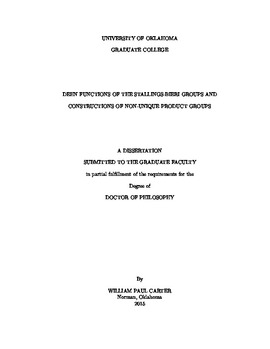| dc.description.abstract | This thesis will consist of two separate halves in which we will present results concerning two different families of finitely generated torsion-free groups. The themes of each half are quite different and are related to certain geometric and non-geometric properties of groups. Considerations for both types of properties allow us to better understand the algebraic structure of such groups.
In the first half of the thesis, we examine the Dehn functions of a family of subgroups of right-angled Artin groups. If $G$ is a finitely generated group, then the Dehn function gives the optimal isoperimetric function of a simply connected 2-complex that is quasi-isometric to the Cayley graph of $G$. In the first half of this thesis, we will show that if a graph $\Gamma$ can be decomposed as a non-trivial join of three smaller subgraphs, then the Bestvina-Brady group, $B_\Gamma$, has a quadratic Dehn function. This result proves that the Stallings-Bieri groups $SB_n$ have quadratic Dehn functions, for $n\geq 3$, establishing a claim made by Bridson.
The second half of this thesis is motivated by the study of two well known conjectures in the theory of group rings over torsion-free groups, namely Kaplansky's Zero Divisor Conjecture and Non-trivial Units Conjecture. Together, they represent basic information we would like to know about any given group ring. It is known that if a group satisfies the unique product property, then any group ring over this group also satisfies both conjectures, and so torsion-free groups that do not satisfy this property are likely candidates for counter examples. Unfortunately, very little is known about torsion-free groups that do not have this property. Specifically, there are only two known examples of such groups, a single group with an explicit presentation, and a family of groups produced via a complex procedure. From these two examples, one can trivially produce infinitely many examples via products and embeddings; however, it is currently unclear how to produce genuinely new examples of such groups. Currently, to demonstrate that such a group does not satisfy this property requires producing two finite sets whose product has no uniquely represented element. We will refer to such sets as a pair of non-unique product sets. In the second part of this thesis, we construct a new non-trivial family of examples with explicit presentations and show that these groups contain arbitrarily large non-unique product sets. | en_US |
